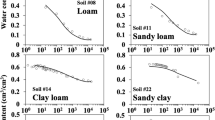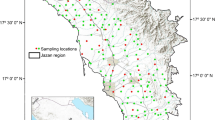Abstract
Applying additives (e.g., biochar and rapeseed-oil residue) to soils is a common agronomic practice used to improve water-retaining capacity. An investigation of water availability and an applicability evaluation of traditional soil water retention curve (SWRC) are therefore necessary for the soil mixed with waste residues. We aimed to investigate the impact of additives on water retention and further to develop models for their prediction. Loam and sandy loam were mixed with different amounts of rapeseed-oil residue and biochar, respectively. And results show that the biochar and rapeseed-oil residue retain more water, with a minimum and maximum increase in soil moisture by approximately 26.2% and 92.7%, and 10.2% and 19.4%, respectively, relative to pure soil. Furthermore, based on the soil capillary theory, modified van–Genuchten (M-VG) and Brooks–Corey (M-BC) models were constructed and compared, which indicate that both the modified physics-based models (M-SWRC) have higher accuracy than the traditional SWRC models in soil moisture prediction; furthermore, the M-VG model outperforms the M-BC model, due to larger R2 and smaller MAPE and RMSE. For the field soils mixed with additives, the soil suction density function has potentials for SWRC model modification based on the soil capillary theory.



Similar content being viewed by others
References
Mollinedo J, Schumacher TE, Chintala R (2015) Influence of feedstocks and pyrolysis on biochar's capacity to modify soil water retention characteristics. J Anal Appl Pyrol 114:100–108
Gul S, Whalen JK, Thomas BW, Sachdeva V, Deng H (2015) Physico-chemical properties and microbial responses in biochar-amended soils: mechanisms and futrue directions. Agric Ecosyst Environ 206:46–59
Obia A, Mulder J, Martinsen V, Cornelissen G, Børresen T (2016) In situ effects of biochar on aggregation, water retention and porosity in light-textured tropical soils. Soil Till Res 155:35–44
Sun F, Lu S (2014) Biochars improve aggregate stability, water retention, and pore-space properties of clayey soil. J Plant Nutr Soil Sci 177:26–33
Xiao Q, Zhu L, Shen Y, Li S (2016) Sensitivity of soil water retention and availability to biochar addition in rainfed semi-arid farmland during a three-year field experiment. Field Crop Res 196:284–293
Jin Z, Chen C, Chen X, Hopkins I, Zhang X, Han Z, Jiang F, Billy G (2019) The crucial factors of soil fertility and rapeseed yield-a five year field trial with biochar addition in upland red soil, China. Sci Total Environ 649:1467–1480
Rekasi M, Szili-Kovacs T, Takacs T, Bernhardt B, Puspan I, Kovacs R, Kutasi J, Draskovits E, Molnar S, Molnar M, Uzinger N (2019) Improving the fertility of sandy soils in the temperate region by combined biochar and microbial inoculant treatments. Arch Agron Soil Sci 65:44–57
Zhang L, Jing Y, Xiang Y, Zhang R, Lu H (2018) Responses of soil microbial community structure changes and activities to biochar addition: a meta-analysis. Sci Total Environ 643:926–935
Zhang M, Wang J, Bai SH, Teng Y, Xu Z (2018) Evaluating the effects of phytoremediation with biochar additions on soil nitrogen mineralization enzymes and fungi. Environ Sci Pollut Res 25:23016–23116
Lu SG, Sun FF, Zong YT (2014) Effect of rice husk biochar and coal fly ash on some physical properties of expansive clayed soil (vertisol). Catena. 114:37–44
Xing X, Li Y, Ma X (2017) Effects on infiltration and evaporation when adding rapeseed-oil residue or wheat straw to a loam soil. Water. 9:700
Xing X, Wang H, Ma X (2018) Brooks-Corey modeling by one-dimensional vertical infiltration method. Water. 10:593
Liu W, Luo X, Huang F, Fu M (2019) Prediction of soil water retention curve using Bayesian updating from limited measurement data. Appl Math Model 76:380–395
Antinoro C, Bagarello V, Ferro V, Giordano G, Iovino M (2014) A simplified approach to estimate water retention for Sicilian soils by the Arya-Paris model. Geoderma. 213:226–234
Shwetha P, Varija K (2015) Soil water retention curve from saturated hydraulic conductivity for sandy loam and loamy and textured soils. Aquat Procedia 4:1142–1149
Gao H, Shao M (2015) Effects of temperature changes on soil hydraulic properties. Soil Tillage Res. 153:145–154
Tyagaraj T, Rao SM (2010) Influence of osmotic suction on the soil-water characteristic curves of compacted expansive clay. J Geotech Geoenviron Eng 136:1695–1702
Xing X, Li Y, Ma X (2018) Water retention curve correction using changes in bulk density during data collection. Eng Geol 233:231–237
Garg A, Garg A, Zhou WH, Tai K, Deo MC (2015) A new simulation approach of genetic programming in modelling of soil water retention property of unsaturated soil. Eng Comput 32:914–930
Wang L, Tang L, Wang Z, Liu H, Zhang W (2020) Probabilistic characterization of the soil-water retention curve and hydraulic conductivity and its application to slope reliability analysis. Comput Geotech 121:103460
Zhou WH, Yuen KV, Tan F (2014) Estimation of soil-water characteristic curve and relative permeability for granular soils with different initial dry densities. Eng Geol 179:1–9
Pan T, Hou S, Liu Y, Tan Q (2019) Comparison of three models fitting the soil water retention curves in a degraded apline meadow region. Sci Rep-UK 9:18
Wang W, Gong Y, Xing X (2020) Groundwater evaporation for salt-affected soil under plastic film-covered cultivation condition: a review. J Soil Sci Plant Nutr. https://doi.org/10.1007/s42729-020-00207-z
Scholl P, Leitner G, Kammerer G, Loiskandl W, Kaul HP, Bodner G (2014) Root induced changes of effective 1D hydraulic properties in a soil column. Plant Soil 381:193–213
Ng CWW, Ni JJ, Leung AK, Wang ZJ (2016) A new and simple water retention model for root-permeated soils. Géotech Lett 6:1–6
Bordoloi S, Garg A, Sreedeep S, Peng L, Mei G (2018) Investigation of cracking and water availability of soil-biochar composite synthesized from invasive weed water hyacinth. Bioresour Technol 263:665–677
Xing X, Ma X (2019) Analysis of cracking potential and modification of soil-water characteristic curve by adding wheat residues. Soil Sci Soc Am J 83:1299–1308
Decagon devices (2016) MPS-2 & MPS-6 dielectric water potential sensors Operator's manual. Decagon Devices, Pullman
Xing X, Kang D, Ma X (2017) Differences in loam water retention and shrinkage behavior: effects of various types and concentrations of salt ions. Soil Tillage Res. 167:61–72
van Genuchten MT (1980) A closed-form equation for predicting the hydraulic conductivity of unsaturated soils. Soil Sci Soc Am J 44:892–898
Brooks RH, Corey AT (1964) Hydraulic properties of porous media. Hydraulic papers. Colorado State University, Fort Collins
Fetter CW (1999) Contaminant hydrogeology, Prentice Hall, pp 176–180
Xing X, Liu Y, Ma X (2019) A modified van-Genuchten model for soil-water retention modeling by considering plant additives. Arch Agron Soil Sci 65:435–449
Mualem Y (1976) A new model for predicting the hydraulic conductivity of unsaturated porous media. Water Resour Res 12:513–522
Garg A, Garg A, Tai K (2014) A multi-gene genetic programming model for estimating stress-dependent soil water retention curves. Comput Geosci 18:45–56
Han X, Shao M, Horton R (2010) Estimating van Genuchten model parameters of undisturbed soils using an intergral method. Pedosphere. 20:55–62
Gardner WR (1968) Availability and measurement of soil water. Water Deficits Plant Growth 1:107–135
Ng CWW, Menzies BK (2007) Advanced unsaturated soil mechanics and engineering. CRC Press
Ajayi AE, Horn R (2017) Biochar-induced changes in soil resilience: effects of soil texture and biochar dosage. Pedosphere 27:236–247
Ulyett J, Sakrabani R, Kibblewhite M, Hann M (2014) Impact of biochar addition on water retention, nitrification and carbn dioxide evolution from two sandy loam soils. Eur J Soil Sci 65:96–104
Wong JTF, Chen Z, Ng CWW, Wong MH (2015) Gas permeability of biochar-amended clay: potential alternative landfill final cover material. Environ Sci Pollut Res 23:7126–7131
Kosugi K, Hopmans JW, Dane JH (2002) “Parametric models.” Methods of soil analysis. Part 4: Physical methods, SSSA Book Series No. 5, Soil Science Society of America, Madison, WI
Valiantzas JD (2011) Combined Brooks-Corey/Burdine and van Genuchten/Mualem closed-form model for improving prediction of unsaturated conductivity. J Irrig Drain Eng 137:223–233
Gao H, Zhang J, Liu C, Man J, Chen C, Wu L, Zeng L (2019) Efficient bayesian inverse modeling of water infiltration in layered soils. Vadose Zone J 18:190029
Yang WH, Clifford D, Minasny B (2015) Mapping soil water retention curves via spatial Bayesian hierarchical models. J Hydrol 524:768–779
Tan F, Zhou WH, Yuen KV (2016) Modeling the soil water retention properties of same-textured soils with different initial void ratios. J Hydrol 542:731–743
Patel S (2012) Threats, managements and envisaged utilizations of aquatic weed Eichhornia crassipes: an overview. Rev Environ Sci Biotechnol 11:249–259
Funding
This work was financially supported by the National Natural Science Foundation of China (grant No. 51809217), the National Natural Science Foundation for Youth Grant Project (grant No. 41907252), and the PhD Research Startup Foundation (grant No. Z109021806).
Author information
Authors and Affiliations
Corresponding author
Additional information
Publisher’s note
Springer Nature remains neutral with regard to jurisdictional claims in published maps and institutional affiliations.
Rights and permissions
About this article
Cite this article
Garg, A., Xing, X. & Bordoloi, S. Water retention models for soils mixed with waste residues: application of the modified van-Genuchten and Brooks-Corey models. Biomass Conv. Bioref. 12, 5059–5066 (2022). https://doi.org/10.1007/s13399-020-00957-x
Received:
Revised:
Accepted:
Published:
Issue Date:
DOI: https://doi.org/10.1007/s13399-020-00957-x




